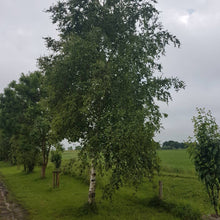Characteristics
The sand birch is also called silver birch and silver birch. In addition, it bears the uncomfortable common name wart birch. The botanical species name is Betula pendula. It can grow to heights of up to 30 meters and widths of up to 12 meters. The hanging growth, like the black and white bark, can be defined as a typical feature of the sand birch.n.
Pollination and foliage
Betula pendula is monoecious. There is both cross-pollination and wind pollination. The green and yellow flowers bloom in March and April. In addition to a simple leaf structure, the leaves have an alternating leaf arrangement along with a sawn leaf edge and a triangular leaf shape.
Soil condition
Betula pendula is happy about gravelly and loamy soil variations with a high humus content. In addition to a moderate nutrient content, an acidic pH value is gratefully accepted. Despite its preference for arid soil variations, Betula pendula has a significant water requirement. So you should pay attention to a sufficient water balance. A sunny location is also gratefully accepted.
Provenance
Betula pendula is particularly common in Scandinavia and Siberia. There it finds an ideal habitat in the mixed coniferous forests with arid sandy soils. It is only not found in the far north of Scandinavia. You can even find stocks on the Asian continent. In the southern Alpine region, she has worked her way up to an altitude of up to 1,900 meters.
Uses
The high ornamental value can hardly be denied due to the already mentioned hanging growth. In forestry, however, people are happy about the numerous other advantages of the sand birch. It can be used for the recultivation of fallow and bare land as well as heathland. Due to its low susceptibility to browsing, the sand birch can score points in forest ecosystems with high wild populations. Betula pendula is often displaced by more competitive species. We therefore advise you to use a planting association with a significant proportion of oak and an admixture of pine. This is how sustainable mixed forests can be put together. If you have any further questions regarding the planning of your forest ecosystem, we will of course be happy to help.






